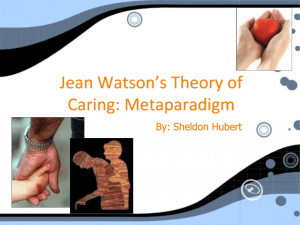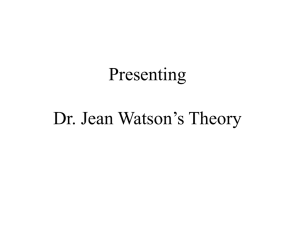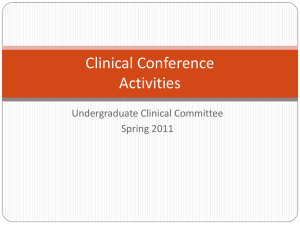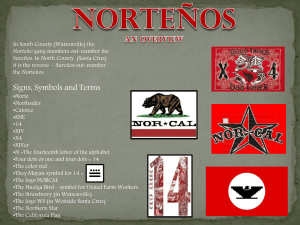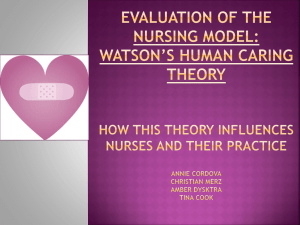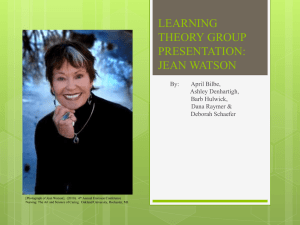JEAN WATSON - Jana De Vries
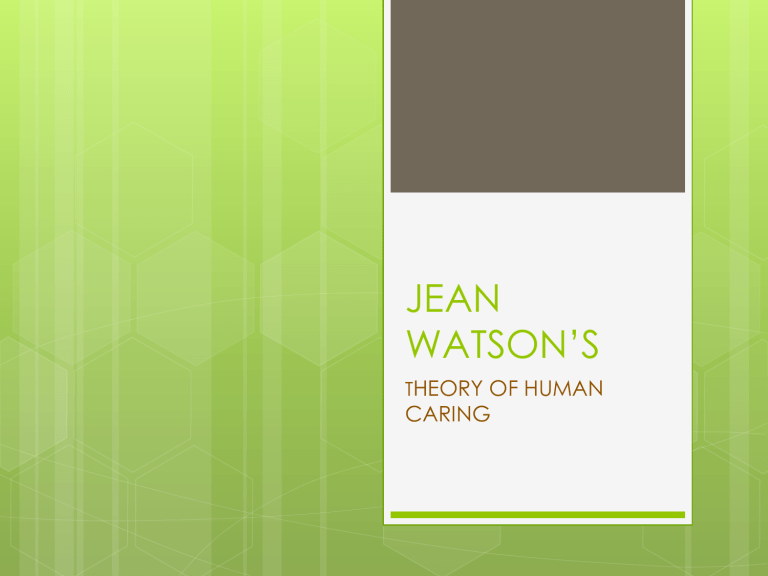
JEAN
WATSON’S
T HEORY OF HUMAN
CARING
Jean Watson’s motto
“We are light in institutional darkness, and in this model we get to return to the light of our humanity.”
Introduction
We have chosen this theory because of it’s focus on “human component” of caring. We believe that this approach is the most beneficial to our patients because it promotes human-to-human connectedness and enhances recovery
We strongly agree with Dr. Watson’s position that in order for healing to occur “Mind, body and spirit has to be aligned” (Kearney-Nunnery, 2008).
Jean Watson’s Biographical
Information
Born in southern West Virginia as a youngest of eight children
Attended Lewis Gale School of Nursing in
Roanoke, Virginia
BSN, University of Colorado,1964
MSN, University of Colorado,1966 (in psychiatricmental health nursing)
PhD, University of Colorado, 1973 (in educational psychology and counseling)
Married in 1961, she has two grown daughters and five grandchildren
Jean Watson’s Biographical
Information
In 2008, she created a non-profit foundation
Watson Caring Science Institute, to further the work of caring science in the World.
Author’s philosophic values about nursing & knowledge development
“Watson defines theory as an imaginative grouping of knowledge, ideas, and experience that are represented symbolically and seek to illuminate a given phenomenon” (Jesse, 2010).
She draws heavily on the sciences and the humanities, providing a phenomenological, existential, and spiritual orientation” (Jesse, 2010).
Author’s philosophic values about nursing & knowledge development
She believes “the emphasis on human caring scholarship combined with core values of relationship, connectedness, and subjectivity of inner human experiences have led to a new connections between caring and healing” (Foster, 2007).
“She cites as background for her theory nursing philosophies and theorists, including
Nightingale, Henderson, Peplau, Rogers and
Newman, and the work of Gadow, a nursing philosopher and healthcare ethicist “ (Jesse,
2010).
Influences on the author’s philosophy
“She was influenced in her earlier work by
Western and Eastern worldviews and by philosophers such as Carl Rogers, Maslow,
Heidegger, Erikson, Kierkegaard, Selye,
Lazarus, Rumi, Whitehead, de Chardin,
Sartre, and Thich Naht Hanh” (Jesse,
2010).
Influences on the authors’ philosophy
“Watson attributes her emphasis on the interpersonal and transpersonal qualities of congruence, empathy, and warmth to the views of Carl Rogers and more recent writers of transpersonal psychology. Watson points out that Carl Rogers’ phenomenological approach, with his view that nurses are not here to manipulate and control others but rather to understand, was profoundly
influential at a time when “clinicalization” was considered the norm” (Jesse, 2010).
Human Caring Diagram
Definition of 4 Global Concepts
(how does this theory defines them)
HUMAN BEING- describes human being as the
“mind, body & soul” indicating that the spirit of the individual is included” (Jesse, 2010).
HEALTH- describes health as “unity and harmony within the mind, body and soul” and illness as the disharmony within the individual’s soul (Jesse,
2010)
ENVIRONMENT- “healing environment at all levels, physical as well as nonphysical, subtle environment of energy and consciousness, whereby wholeness, beauty, comfort, dignity, and peace are potentiated” (Kearney-Nunnery, 2008).
Definition of 4 Global Concepts
NURSING- as “promoting health, preventing illness, and restoring health by means of the holistic approach between nurse and patient” (Jesse, 2010)
“Nursing practice is directed toward helping person gain a higher degree of harmony within the mind, body and soul” (Kearney-
Nunnery, 2008)
This model does not add to the existing concepts
Clarification of Origins
This theory can be practiced at any level of nursing, but also in a real life situations because of the “human-to-human” connectedness factor and emphasis on relationships
It can be used in any “kind of nursing”
(OB, ER, Medical/Surgical etc.).
The concepts are specific to this theory
Examples of practice situations
Watson’s nursing theory can be used in
Hospice care to provide the best possible care during the dying process and creating an environment that would provide support and caring.
This theory can also be used in labor and delivery as the nurse has a huge impact on providing nursing care for a mother and child during the birthing process and postpartum by allowing the patient to express needs.
Examples of practice situations
In a situations, where patient care is focused on the non-verbal cues of patients which can’t communicate
(whether it is due to a language barrier, speech impediment or cognitive impairment).
Lisa Watson’s References
Jesse, D.E., (2010). Watson's philosophy and theory of transpersonal caring. In M.A. Tomey, &
M.R. Alligood (Eds.), Nursing theorist and their work (pp. 91-112). Missouri: Mosby.
Foster, R.L., (2007). Tribute to the theorist: Jean Watson over the years. Nursing Science
Quarterly, 20(1). doi:10.1177/0894318406296469 http://www.currentnursing.com/nursing_theory/watson.htm
Jana De Vries’s References
: http://www.watsoncaringscience.org
Kearney-Nunnery, R. (2008). Advancing Your Career: Concepts of Professional Nursing. Philadelphia:
F.A. Davis Company, 4, p. 73-74.
Myra Marshall-Mixco’s
References
Jesse, D. E. (2010). Jean Watson: Watson’s philosophy and theory of transpersonal caring. In
Alligood, M. R., & Tomey, A. M., Nursing theorists and their work ( 7 th
ed., pp. 91-112).
Maryland Heights, MO: Mosby Elsevier.
Kearney-Nunnery, R. (2008). Advancing your career: Concepts of professional nursing (4 th
ed., pp
73-74). Philadelphia: F.A. Davis Company.
Brenda Strickland’s References
Watson, J. (2001) jean Watson: Theory of human caring. In M.E. parker (Ed.),
Nursing theorist and nursing practice
(pp. 343-354). Philadelphia: Davis.
www.humancaring.org
